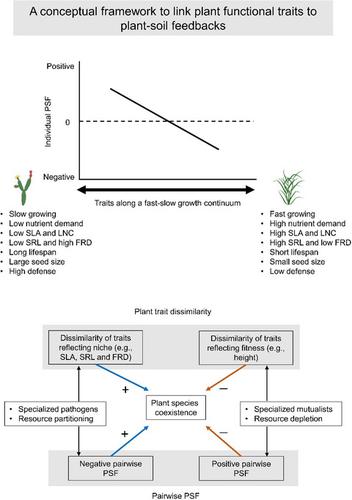Our official English website, www.x-mol.net, welcomes your feedback! (Note: you will need to create a separate account there.)
Relationships between plant–soil feedbacks and functional traits
Journal of Ecology ( IF 5.5 ) Pub Date : 2021-06-17 , DOI: 10.1111/1365-2745.13731 Nianxun Xi 1 , Peter B. Adler 2 , Dongxia Chen 1 , Hangyu Wu 1 , Jane A. Catford 3 , Peter M. van Bodegom 4 , Michael Bahn 5 , Kerri M. Crawford 6 , Chengjin Chu 1
中文翻译:

植物-土壤反馈与功能性状之间的关系
更新日期:2021-06-17
Journal of Ecology ( IF 5.5 ) Pub Date : 2021-06-17 , DOI: 10.1111/1365-2745.13731 Nianxun Xi 1 , Peter B. Adler 2 , Dongxia Chen 1 , Hangyu Wu 1 , Jane A. Catford 3 , Peter M. van Bodegom 4 , Michael Bahn 5 , Kerri M. Crawford 6 , Chengjin Chu 1
Affiliation

|
- Plant–soil feedbacks (PSF) and functional traits are two active but not well theoretically integrated areas of research. However, PSF and traits are both affected by life-history evolution, so the two should theoretically be related.
- We provide a conceptual framework to link plant functional traits to two types of PSF metrics, and hypothesize that individual PSF (plant performance in conspecific vs. heterospecific soil) should be related to the fast–slow trait spectrum, whereas pairwise PSF (the sum of the individual feedbacks for two species growing in each other's soils) should be related to trait dissimilarity. We performed meta-analyses to test these hypotheses by compiling two datasets, one dataset consisting of individual PSF values and plant trait values (specific leaf area, SLA; leaf N concentration, LNC; specific root length, SRL; fine root diameter, FRD; plant height; seed mass), and the second consisting of pairwise PSF values and trait dissimilarity.
- Our meta-analyses showed that individual PSF values were more negative in faster-growing species with greater SLA, LNC and SRL, supporting the growth–defence trade-off hypothesis. Plant height was positively correlated with individual PSF, perhaps because large, long-lived plants defend against pathogens better than smaller, shorter-lived plants. We also found that larger-seeded species had more positive or less negative PSF, likely reflecting greater tolerance of soil pathogens. The direction of relationships between trait dissimilarity and pairwise PSF varied with trait identity. Dissimilarities in SRL and FRD were negatively correlated with pairwise PSF while height dissimilarity was positively correlated with pairwise PSF. The contrasting relationships may reflect distinct links between trait dissimilarity and niche and fitness differences.
- Synthesis. Our results demonstrate how an integration of PSF and trait-based approaches can advance plant community ecology.
中文翻译:

植物-土壤反馈与功能性状之间的关系
- 植物-土壤反馈 (PSF) 和功能性状是两个活跃但在理论上没有很好整合的研究领域。但是,PSF和性状都受到生活史进化的影响,所以理论上两者应该是相关的。
- 我们提供了一个概念框架将植物功能性状与两种类型的 PSF 指标联系起来,并假设单个 PSF(同种与异种土壤中的植物性能)应该与快慢性状谱相关,而成对 PSF(在彼此的土壤中生长的两个物种的个体反馈)应该与性状差异有关。我们通过编译两个数据集进行荟萃分析来检验这些假设,一个数据集由单个 PSF 值和植物性状值(比叶面积,SLA;叶氮浓度,LNC;比根长度,SRL;细根直径,FRD;植物高度;种子质量),第二个由成对的 PSF 值和性状差异组成。
- 我们的荟萃分析表明,在具有更大 SLA、LNC 和 SRL 的快速生长物种中,个体 PSF 值更负,支持生长-防御权衡假设。植物高度与单个 PSF 呈正相关,这可能是因为大型、长寿的植物比较小、寿命较短的植物更能抵御病原体。我们还发现,较大种子的物种具有更多的阳性或更少的阴性 PSF,这可能反映了对土壤病原体的更大耐受性。性状差异与成对 PSF 之间的关系方向因性状同一性而异。SRL 和 FRD 的差异与成对 PSF 呈负相关,而身高差异与成对 PSF 呈正相关。对比关系可能反映了性状差异与生态位和适应度差异之间的明显联系。
- 合成。我们的结果证明了 PSF 和基于性状的方法的整合如何促进植物群落生态学。



























 京公网安备 11010802027423号
京公网安备 11010802027423号